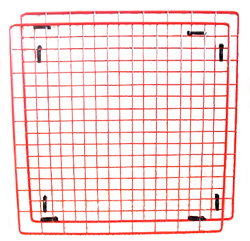Cubes and Coroplast Cages
Cubes and Coroplast cages are used by pet owners and guinea pig enthusiasts around the world and have been for over a decade! Everyone highly recommends the C&C Cage solution. The features of these cages makes a GREAT experience for the guinea pigs and their caretakers alike. There are so many wonderful benefits.
- Easy-to-clean
- Easy-to-assemble
- Easy-to-change design
- Can choose colors
- Esthetically pleasing
- Durable
- Good visibility
- Good air circulation
|
- Can add levels
- Can cat-proof
- Re-use, recycle materials
- Fit them anywhere, adaptable
- Easy-to-decorate
- Lightweight
- Easy to expand, reduce, divide
- Collapsible to store
|
Generally Accepted Cage Size Standards
These are the standards, showing the absolute minimum cage sizes required as well the preferred cage sizes recommended.
| MINIMUM
|
Number of
Guinea Pigs*
|
PREFERRED
|
| Area
|
Grids
|
Size
|
Area
|
Grids
|
Size
|
7.5 ft²
|
2x3 grids
|
27" x 41"
|

|
10.5 ft²
|
2x4 grids
|
27" x 56"
|
| 7.5 ft²
|
2x3 grids
|
27" x 41"
|
 
|
10.5 ft²
|
2x4 grids
|
27" x 56"
|
| 10.5 ft²
|
2x4 grids
|
27" x 56"
|
  
|
13 ft²
|
2x5 grids
|
27" x 71"
|
| 13 ft²
|
2x5 grids
|
27" x 71"
|
   
|
16 ft²
|
2x6 grids
|
27" x 84"
|
Cage Safety
We use the 'safe grids' -- the inner holes are 1.5 inches. Grids with inner holes greater than 1.5 inches are too dangerous. But, even with the SAFE grids, you MUST BABY-PROOF your cage if you have young or small guinea pigs. Guinea pigs grow very quickly and are usually fine with grid walls at a few months old. But, you have to use your good judgement and common sense. Some guinea pigs are small in size and some have very narrow-shaped heads. In those cases, you may need to make adjustments for about 6 months to be safe.
Baby-proofing a C&C Cage
Baby-proofing is a temporary requirement. You can do a few different things. You can make the coroplast walls higher with some scrap pieces of Coroplast or even cardboard. Nine inch walls will be fine for babies. You can remove the temporary walls when the guinea pigs are large enough. OR, you can use cable ties and some extra grids, you can double up the grids in an overlay pattern, reducing the inner holes by half.

To baby proof, you can go with one of the following:
#1) EXTEND the internal Coroplast Walls to be higher
#2) REDUCE the inner grid-hole openings
#3) BLOCK access to the grid-walls
How to:
- Use some scrap Coroplast or even Cardboard to attach to the Coroplast wall between the wall and the grids. You can tape or binder-clip the extra pieces in place. Adding just a few inches in height will be fine. Just pay attention to what you have in the cage and make sure they can't get to the top of the wall.
- Overlap extra grids. If you have some extra grids around, double up on the perimeter grids by overlapping them to cut the inner grid-hole opening in half or quarters. You can cable-tie them in place and remove when no longer needed. You can use a full-grid to accomplish this or you can use our half-height grids as well to cover the area just at and above the top of the Coroplast wall.
- Use our Pig-a-Boo acrylic windows which are half-height with holes drilled in the corners. You can attach them directly to the grid walls at the top of the Coroplast wall.
All can be removed and reused when the guinea pigs are big enough.